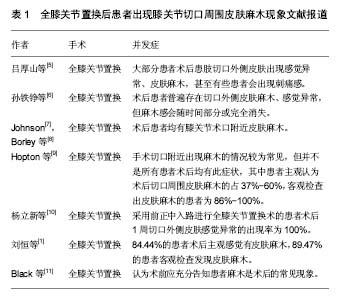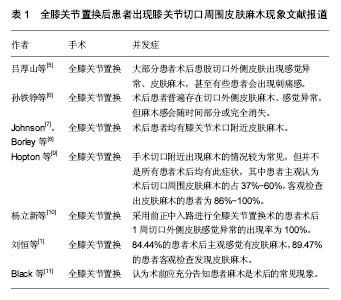Chinese Journal of Tissue Engineering Research ›› 2017, Vol. 21 ›› Issue (31): 5048-5053.doi: 10.3969/j.issn.2095-4344.2017.31.022
Previous Articles Next Articles
Dermal hypoesthesia surrounding the incision after total knee arthroplasty: how to treat?
Han Yan-hong1, Pan Jian-ke2, Liu Jun2, Yang Wei-yi2, Cao Xue-wei2, Guo Da2
- 1Second School of Clinical Medicine, Guangzhou University of Chinese Medicine, Guangzhou 510405, Guangdong Province, China; 2Department of Orthopedics, the Second Affiliated Hospital of Guangzhou University of Chinese Medicine & Guangdong Provincial Hospital of Chinese Medicine, Guangzhou 510120, Guangdong Province, China
-
Online:2017-11-08Published:2017-12-01 -
Contact:Liu Jun, Chief physician, Professor, Doctoral supervisor, Postdoctoral supervisor, Department of Orthopedics, the Second Affiliated Hospital of Guangzhou University of Chinese Medicine & Guangdong Provincial Hospital of Chinese Medicine, Guangzhou 510120, Guangdong Province, China -
About author:Han Yan-hong, Studying for master’s degree, Second School of Clinical Medicine, Guangzhou University of Chinese Medicine, Guangzhou 510405, Guangdong Province, China -
Supported by:the National Natural Science Foundation of China, No. 81473698 and 81273781; the Doctoral Fund of Ministry of Education of China, No. 20124425110004; the Science and Technology Program of Guangdong Province, No. 2011B031700027; the Project of the Department of Finance of Guangdong Province, No. [2014]157; the Project of Traditional Chinese Medicine Bureau of Guangdong Province, No. 20164020; the Traditional Chinese Medicine Research Project of Guangdong Provincial Hospital of Chinese Medicine, No. YK2013B2N19 and YN2015MS15
CLC Number:
Cite this article
Han Yan-hong, Pan Jian-ke, Liu Jun, Yang Wei-yi, Cao Xue-wei, Guo Da. Dermal hypoesthesia surrounding the incision after total knee arthroplasty: how to treat? [J]. Chinese Journal of Tissue Engineering Research, 2017, 21(31): 5048-5053.
share this article
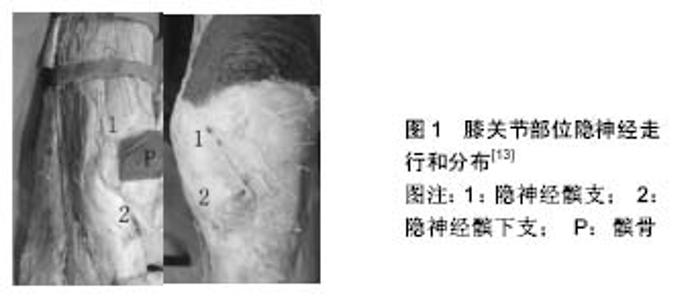
2.2 膝关节周围神经分布 膝关节部位周围神经分布可以分为浅、深2层,浅层为皮神经,膝关节前部分布有四五支骨中间皮神经,而膝内侧皮神经变异较大,分布有股内侧皮神经、隐神经分支等,膝后部有闭孔神经和股后皮神经分布;深层是由分布在关节囊、周围韧带和进入关节内的关节支组成,而目前研究认为全膝关节置换术后皮肤麻木和感觉异常主要是由膝部皮神经损伤导致[12]。 2.2.1 股外侧皮神经 起自腰丛,一般在大腿外侧部位恒定出现,为L1或L2神经根的终末支,分布在髌骨的外上部和股四头肌腱外侧部皮肤以及浅筋膜处,而其中下外分支延伸至膝关节外侧水平并支配大腿外侧的皮肤,终末支延伸至髌骨上缘时会变得非常细小,通常因融入筋膜结构中而难于区分开来。 2.2.2 股中间皮神经 由腰丛发出,从股神经腹股沟处向下分出两三支,末端再继续分为许多细小分支,主要分布在股四头肌腱和髌骨区域的皮肤及浅筋膜上。 2.2.3 股后皮神经 起自于骶丛,从大腿后侧中线下行,于腘部分出三四分支,末端再延伸出许多细小的分支,分布在腘区皮肤和浅筋膜上。 2.2.4 隐神经 隐神经主要起源于股神经后部的分支,与股动脉相伴下行,在股下端内侧部再细分出上、下两支,余正红等[13]通过80例成人标本研究发现上支出现率60%常被称为“股内侧皮神经”,而下支为隐神经髌下支,在膝关节内侧的出现率为100%。隐神经分支不但浅出支配膝关节局部的皮肤、浅筋膜层,而且分布在关节囊周围,并深入到膝关节内。 根据隐神经在膝关节周围分支不同目前可分为3型,包括Ⅰ型、Ⅱ型、Ⅲ型,其中高兴华等[12]的研究发现Ⅲ型约占75%,Ⅰ型仅有髌下支,因人体性别、身高、体质量等因素的影响,其分布区域、范围不尽相同;Ⅱ型的分支包括上支以及髌下支,上支一般分支较少(通常称为股内侧皮神经),主要分布在膝内侧上部的皮肤;Ⅲ型分支包括粗大的上支和髌下支,上支在膝关节前方紧贴深筋膜下方走行于股下部缝匠肌和股内侧肌的夹角中,在髌骨内上角处穿出深筋膜后再分为髌支以及髌腱支,髌支在髌骨内上角处进入髌前皮下,分布于髌骨前面皮肤,髌腱支自后内向前下外,斜跨股骨内髁和髌内侧支持带,在股骨内髁前方处分为2支,其上支和下支都再发出分支,呈手指状分开并分布在髌骨下缘、髌腱、髌内侧支持带,部分越过髌腱至外侧髌支持带。髌下支自深筋膜穿出后紧贴深筋膜走行于缝匠肌与股薄肌之间,通常在关节间隙平面近端处发出2支,其中前支一般穿过缝匠肌或沿着缝匠肌前缘走行至髌腱处,而后支走行在缝匠肌深面,于股骨内上髁平面从缝匠肌的后缘穿出,自后上方向前下方走行于缝匠肌浅面,最后加入髌神经丛起始处。在缝匠肌前缘部再分为爪状的3支,上支分布在前内侧关节囊处,中支分布在髌腱下部和胫骨结节处,下支则分布于鹅足部以及胫骨上端前内侧皮肤。见图1。 "
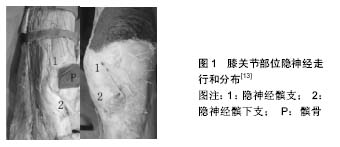
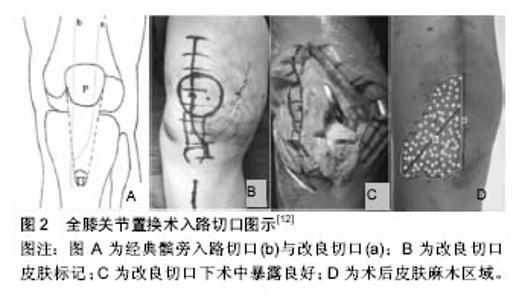
2.3 病因 2.3.1 皮神经损伤 大多数学者认为全膝关节置换术后患者出现切口周围皮肤感觉异常、麻木主要与手术过程中损伤皮神经有关。膝关节前正中切口作为全膝关节 置换术的经典手术入路之一,临床上大多采用此入路,其切口一般起自髌骨上方5-10 cm向下延长至胫骨结节内侧缘,而股中间皮神经、隐神经髌下支、股内侧皮神经、腓肠外侧皮神经分布在膝关节前方进而形成髌神经丛[14],因此不可避免的会切断膝关节前方的皮神经,从而导致人工全膝关节置换术后患者出现术口周围皮肤麻木。一般认为,隐神经髌下支支配膝关节前方的感觉,隐神经髌下支在此出现率为100%,术后皮肤麻木主要由此损伤导致[7,15]。 Tanavalee等[16]通过对尸体的研究也表明,隐神经始终没有分支通过膝关节中线以上,因此,在切口上部损伤皮神经的可能较少。刘恒等[1]研究发现,全膝关节置换术后患者的皮肤麻木区域完全在术口外侧的占88.6%,而11.40%的患者麻木区域下部会越过切口远端达到内侧皮肤,其中大部分患者的麻木区域是以切口作为內缘,外周性状不规则的闭合图形。这种麻木区域的分布规律与皮神经支配范围相对应正好印证了全膝关节置换术后皮肤麻木的皮神经损伤学说。 2.3.2 血管-组织缺氧 一般认为隐神经髌下支在膝关节的走行比较固定,所以在全膝关节置换术中难以避免将其损伤。若切口周围皮肤麻木单纯与膝关节周围的皮神经损伤有关,那么全膝关节置换术后皮肤麻木的发生率应该为100%,但结果并非这样。因此,也有不少研究者提出其他的假设:血管-组织缺氧。 Johnson等[17]通过对膝关节周围皮肤的氧含量进行测量发现,在全膝关节置换术后的切口外侧皮肤经皮氧含量均比术前低。髌旁内侧切口与前正中切口相比,因为切口外侧皮瓣面积较大,其皮肤氧分压更低。 Subramanian等[18]的研究恰好证实了这一观点,该研究发现全膝关节置换切口距离股骨内侧髁越近,术后患者皮肤麻木区域就越大。全膝关节置换中止血带应用时间超过120min的患者中78%术后发生了膝关节切口周围皮肤麻木,由于使用止血带的时间过长导致切口外侧皮瓣组织缺氧的情况更重[1]。 2.4 防治进展 2.4.1 预防神经损伤 全膝关节置换主要的手术入路有内侧髌旁入路、股内侧肌下入路和股中间肌入路,其中内侧髌旁入路最为经典,该入路从髌骨内侧1/3延伸至胫骨结节内侧1 cm,能够充分显露膝关节,方便安装,但会损伤隐神经髌下支,容易出现术后皮肤麻木[19]。因此,Mǖller建议采用膝关节前外侧入路,在深筋膜下分离组织避免损伤神经[20]。但在临床上,骨科医生在遇到外翻膝需要松解外侧组织时,才会选择膝关节前外侧入路,对于大部分内翻膝的患者来讲,虽然可以减少神经损伤的可能,却增加了许多显露的弊端。而Tanavalee等[16]通过比较微创切口和标准切口术后的区别,结果发现全膝关节置换术后患者麻木区域的未见明显的差异。为了探讨是否存在减少术后麻木的全膝关节置换术切口安全区,高兴华等[12]通过尸体标本观察隐神经髌下支的分布特点改良全膝关节置换术手术切口,改良后的切口以髌骨外侧1/3点、髌韧带中点连线,近端向膝前正中延长切口,远端向下、向内绕胫骨结节内侧缘延长切口,形成“J”型切口,见图2。与传统的切口相比,改良后的切口显露良好,未影响假体安装,皮肤浅感觉障碍发生率及术后麻木区域明显降低。"
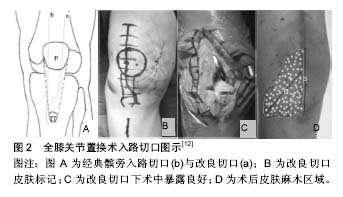

2.4.2 治疗 目前全膝关节置换术后患者切口周围皮肤麻木并不像其他术后并发症一样引起临床骨科医生的重视,其治疗方式在国内外也未见明确的文献报道[1]。面对这一现象,大多数临床医生往往会在术后经验性地给予患者一些营养神经的药物,但其是否存在确切的临床疗效也未见文献报道。 在过去的几十年里,对于外周神经损伤修复的基础研究取得了显著的进步,但在临床治疗方面还未取得确切的疗效。近年来,周围神经损伤后的修复治疗主要包括生物分子治疗、细胞治疗以及导管治疗等,而其中神经营养因子能有效的促进感觉神经元的存活、出芽和分支[21]。虽然这些治疗方法也有应用于全膝关节置换术后患者皮神经损伤修复的研究,但是其临床研究仍处于试验阶段,其安全性、有效性仍需进一步研究确定。 ⑴神经营养因子:损伤后的神经再生与损伤部位、程度、性质以及个体差异有着密切的关系,一般而言外周神经的修复效果优于中枢神经的修复,外周神经部分性断裂损伤的修复效果优于完全性神经断裂损伤。 近年来,随着分子生物学的快速发展,从分子水平的研究发现神经元靶器官分泌的神经营养因子是神经细胞存活的依赖因子和发育成熟神经元功能的调控因子,也是神经元受损或病变中保护其存活以及促进其再生的必需因子[22]。神经营养因子可分为神经营养素家族、细胞因子家族、成纤维细胞生长因子家族、胶质细胞源性神经营养因子以及细胞外基质分子等,其主要通过促进神经再生、促进神经芽生以及保护神经元等作用修复损伤的神经[23]。目前在周围神经修复的研究中,神经营养因子的研究主要集中在神经生长因子、重组睫状神经营养因子以及胶质性神经营养因子,各因子的主要受体和作用机制都得到较好的阐释,但各因子的副作用仍不明确,应用于全膝关节置换后患者的疗效如何及运用哪一种途径给药也存在较大的争议[24],这也是今后研究的一个方向。 ⑵神经导管:神经导管是一种天然高分子材料,适合细胞之间的黏附及铺展,有利于神经组织细胞的黏附、迁移、增殖和分化[25]。神经导管在周围神经修复过程中的作用主要是为神经修复和再生提供一个较为稳定的微环境,其具有良好的三维空间仿生性,能够有效的促进神经趋化再生。有研究者应用不可降解的硅胶管等材料作为神经导管,用于神经损伤修复试验,研究结果发现其有利于损伤后的神经再生,有新生成血管出现在再生的神经内,而且再生的神经纤维、髓鞘厚度以及轴突密度有明显的提高,但是存在人为造成神经卡压症状等缺陷。 目前较常用的可降解生物材料包括聚乳酸、壳聚糖、胶原、静脉管和动脉管等,其中静脉管已经应用在动物实验中,研究结果表明其具有一定的促进损伤神经修复的作用[26-27]。但应用于全膝关节置换术后皮神经损伤修复,俨然存在其不足,比如皮神经本身较细小修复难度大,导管弹性、脆性要求高,在神经修复中也容易被周围组织压迫导致狭窄,在神经修复时容易塌陷,导致再生轴突长入时妨碍神经的再生。临床应用有一定程度的限制,例如医疗费用较高、技术不成熟和手术介入时机等问题,但其作为一种有效的修复方法,也将是今后研究的方向。 ⑶神经营养药物:现代药理学研究表明,临床上有些药物在周围神经损伤修复中,具有保护神经、促进神经轴突再生等作用。冯之静等[28]应用前列地尔和甲钴胺治疗糖尿病周围神经病变患者,发现前列地尔治疗效果优于甲钴胺,治疗后两组患者周围神经的传导速度显著提高,其中前列地尔能够通过改善神经营养提高糖尿病患者周围神经传导速度。也有研究发现胰岛素样生长因子1能够保护神经细胞和促进细胞分裂增殖,可能具有促进损伤神经修复的功能[29]。 近年研究发现胰岛素样生长因子1对运动、感觉以及交感神经具有营养支持的作用[30]。有实验研究报道糖末宁颗粒剂能够上调胰岛素样生长因子1蛋白的表达,从而降低损伤后大鼠坐骨神经细胞凋亡的速度,对病变的坐骨神经起到一定的保护作用[31]。重组促红细胞生成素具有造血功能,其临床上主要应用于血液疾病的治疗。而近年来的研究发现重组促红细胞生成素能够起到营养神经以及保护神经的作用[32]。 目前许多从事药理研究的学者在周围神经修复的基础和临床中都取得不少研究成果,但是并没有研究从药理学作用机制上明确地阐明其在周围神经损伤修复过程中的作用。对于全膝关节置换术后皮神经损伤的防治中,临床医生常规术后应用神经营养药物,但其具体的作用机制和临床疗效仍缺乏有效的证据支持,这也是今后的研究方向之一。 ⑷手术修复:神经修复包括自体神经移植和异体神经移植,其中自体神经移植作为周围神经缺损修复的金钥匙,主要移植相对次要的周围神经进行端端吻合从而修复神经缺损,目前多采用神经束和功能束匹配吻合。朱家恺等[33]的研究显示单束神经移植方法对术后再生的有髓神经纤维数、髓鞘厚度、轴突直径等均较常规方法显著升高。但自体神经移植仍面临许多问题,例如供体来源有限,难以符合长段神经缺损要求,而且其他区域感觉神经切取后供区将遗留新的损伤,造成人为的感觉障碍和功能丧失等[34]。 对于全膝关节置换后导致局部皮神经的损伤修复而言,单束神经移植法在理论上具有先进性与可行性,但在临床实际应用中仍上存在一定的难度,例如供体感觉神经的选择、修复技术的不成熟以及修复成本等问题,所以日后还需在进一步的研究。异体神经移植则可以解决自体神经来源的问题,但其面临的主要问题是免疫排斥。 如何保证神经修复的疗效又能排除免疫排斥反应长久以来都是研究的热点。有学者认为,免疫抑制剂具有一定疗效,但存在较大的不良反应,长期应用可能会引起其他器官功能损害。化学去细胞技术作为近年来兴起的新技术,能够有效降低异体神经移植修复过程中的免疫排斥反应,杨润功等[35]的研究表明临床上应用去细胞同种异体神经移植修复周围神经损伤是安全可靠的。但总体而言,无论是自体神经移植还是异体神经移植在全膝关节置换术后皮神经的修复研究中仍处于试验阶段,在临床实际应用中存在诸多问题,仍需今后进一步研究。 2.5 预后转归 全膝关节置换术中切口难以避免会对膝关节前方的皮神经造成损伤,虽然人体外周神经损伤后具有一定的再生及自我修复能力,但由于神经细胞不具备分裂能力及穿透性生长等特性,因此,全膝关节置换术后外周皮神经损伤的完全修复还是十分困难的[1]。因为外周神经系统结构特点以及再生特性,其预后具有较多的不确定性,可能与患者损伤部位、程度、性质等有关。 Subramanian等[18]通过对26例患者进行2年时间的随访,发现13例患者皮肤麻木区域完全消失,6例患者麻木区域逐渐减小,6例患者区域面积没有明显变化,仅有1例患者皮肤麻木面积增大。Tanavalee等[16]通过对30例患者1年的随访发现,全膝关节置换后患者皮肤麻木的区域随着时间推移逐渐的缩小。孙铁铮等[6]研究发现切口外侧皮肤麻木区域与患者的年龄、左右侧别、引流量、出血量、体质量指数以及假体类型均无相关,而皮肤麻木面积在术后1.5年内随时间推移逐渐减小,这与Tanavalee和Black等的研究结果相似,说明损伤的神经纤维出现生长或代偿。Berg等[36]的研究表明由于膝关节切口外侧存在大小不一的皮肤感觉麻木区域,往往不同程度的引发患者担忧,从而影响到全膝关节置换后患者康复的情绪及功能锻炼。刘恒等[1]通过对132例患者的研究发现大部分全膝关节置换后的患者会发生术口附近皮肤麻木,术后2年内麻木的区域会随时间推移逐步缩小,但皮肤麻木范围2年之后将不会再发生明显变化,此外,皮肤麻木区域大小和患者的性别、年龄、止血带使用时间没有明显相关性。由此可见,大多数全膝关节置换患者术后切口周围的皮肤麻木区域会随着时间的推移而逐渐缩小甚至完全消失,但具体的恢复时间长短因人而异并无统一的时间界限。"

| [1] 刘恒,文立成,曹永平,等.膝关节置换术后切口周围皮肤麻木的研究[J].北京大学学报(医学版),2012,44(6):882-886.[2] Frankowski JJ,Watkins-Castiello S.Primary Total Knee and Hip Arthropalasty:Projections for the U.S.Population to the Year 2030.Rosemont,IL.AAOS Dept of Research and Scientific Affairs.2007:1-8.[3] Althausent PL,Lee MA,Finkemeier CG,et al.Operative stabilization of superacondylar femur fractures above total knee arthroplasty:a comparision of four treatment methods.J Arthroplasty.2003;18(7):834-839.[4] Kurtz SM,Ong KL,Lau E,et al. International survey of primary and revision total knee replacement.Int Orthop.2011;35(12): 1783-1789.[5] 吕厚山.膝关节置换并发症的诊断和治疗[J].人民卫生出版社, 2008:49-61.[6] 孙铁铮,杨艺,吕厚山.全膝关节置换术后切口外侧皮肤感觉障碍的随访观察[J].中华骨科杂志,2012,32(5):437-441.[7] Johnson DF,Love DT,Love RT,et al.Dermal hypoesthesia after total knee arthroplasty.Am J Orthop. 2000;29(11): 863-866.[8] Borley NR,Edwards D,Villar RN.Lateral skin flap numbness after total knee arthroplasty.Arthroplasty.1995;10(1):13-14.[9] Hopton BP,Tommichan MC,Howell FR.Reducing lateral skin flap numbness after total knee arthroplasty.Knee.2004; 11(4): 289-291.[10] 杨立新,吴旭,孟昭宇,等.人工膝关节置换术后切口外侧皮肤感觉障碍转归的5年随访研究[J].中国骨与关节损伤杂志,2016, 31(4):365-368.[11] R Black,C Green,D Sochart.Postoperative numbness of the knee following total knee arthroplasty.Ann R Coll Surg Engl. 2013;95:565-568.[12] 高兴华,刘永轶,王敏聪,等.膝关节置换术后皮肤麻痹的解剖基础及相关临床研究[J].中国临床解剖学杂志,2016,34(2):121-125.[13] 余正红,蔡胥,赵卫东,等.膝关节神经分布的解剖学研究及其临床意义[J].中国临床解剖学杂志,2008,26(1):11-16.[14] Williams PL,Warwick R,Dyson M,et al.Gra’s Anatomy[M].New York:Churchill Livingstone.1989.[15] Kerver A,Leliveld MS,Hartog D,et al.The surgical anatomy of the infrapatellar branch of the saphenous nerve in relation to incisions for anteromedial knee surgery. J Bone Joint Surg Am.2013;95(23):2119-2125.[16] Tanavalee A, Limtrakul A, Veerasethsiri P, et al.Area of Skin Numbness After Total Knee Arthroplasty: Does Minimally Invasive Approach Make Any Difference From Standard Approach?. J Arthroplasty. 2016;31(11):2499-2503.[17] Johnson DP.Midline or parapatellar incision for kneearthroplasty.A comparative study of wound viability.J Bone Joint Surg Br.1988;70(4):656-658.[18] Subramanian S,Lateef H,Massraf A.Cutaneous sensory loss fol-lowing primary total knee arthroplasty.A two years follow-up study.J Acta Orthop Belg.2009;75(5):649-653.[19] Laffosse JM,Potapov A,Michel M,et al. Hypesthesia after Anterolateral versus Midline Skin Incision in TKA: A Randomized Study.Clin Orthop Relat Res.2011;469:3154-3163.[20] Mǖller W.The Knee:Form,Function and Ligament Reconstruction[M].Heidelberg, Germany, Springer-Verlag.1983.[21] Matheson CR,Carnahan J,Urich JL,et al.Glial cell line-derived neurotrophic factor ( GDNF) is a neurotrophic factor for sensory neurons: comparison with the effects of the neurotrophins. J Neurobiol.1997;32(1):22-32.[22] 周建,孙克华.神经损伤后的再生与神经营养因子[J].中国微侵袭神经外科杂志,2006,11(1):36-38.[23] Chen ZY, Chai YF, Cao L, et al. Glial cell line-derived neurotrophic factor enchances axonal regeneration following sciatic nerve transection in adult rats. Brain Res.2001; 902(2): 272-276.[24] 吴林清,殷超,景尚斐,等.周围神经损伤后修复再生的研究进展[J].中华临床医师杂志:电子版,2014,8(7):1338-1341.[25] 朱继翔,彭晔,田秀梅,等.神经组织工程支架材料的研究进展[J].中国医药指南,2013,11(32):342-343.[26] Werner MU, Bischoff JM,Rathmell JP,et al.Pulsed radiofrequency in the treatment of persistent prain after inguinal herniotomy: a systematic review. Reg Anesth Pain Med.2012;37(3): 340-343.[27] Tos P, battiston B, Ciclamini D, et al . Primary repair of crush nerve injuries by means of biological tubulization with muscle-vein-com-bined grafts. Micrsurgery. 2012;32(5): 358-563.[28] 冯之静.甲钴胺与前列地尔改善糖尿病周围神经病变患者周围神经传导速度的效果分析[J]. 实用心脑肺血管病杂志, 2013, 21(3):101-102.[29] 李江,董作亮.胰岛素样生长因子-1的研究进展[J].国际检验医学杂志,2013,34(7):848-850.[30] Alonso A, Gonzalez C. Neuroprotective role of estrogens: relationship with insulin/IGF-1 signaling. Front Biosci(EliteEd). 2012;4: 607-619.[31] 王巍,于世家,于彩娜.糖末宁颗粒剂对糖尿病周围神经病变大鼠坐骨神经NGF、IGF-1表达的影响[J]. 北京中医药大学学报, 2010,33(5):346-349.[32] 胡杨,秦文,廉凯.促红细胞生成素对大鼠脊髓运动神经元缺氧性损伤的保护作用[J]. 中国康复理论与实, 2014, 20(2): 133-136.[33] 朱家恺.现代周围神经外科学[M]. 上海:上海科学技术出版社, 2007:384-385.[34] “神桥”——一种有希望的新型周围神经修复材料[J].中华显微外科杂志, 2013, 36(1): 1-2.[35] 杨润功, 衷鸿宾, 朱加亮,等. 去细胞同种异体神经移植修复周围神经缺损临床安全性研究[J]. 中华外科杂志, 2012, 50(1): 74-76.[36] Berg P,Mjoberg B.A lateral skin incision reduces peripatellar dysaesthesias after knee surgery.J Bone Joint Surg Br.1991; 73(3):374-376. |
| [1] | Wang Jianping, Zhang Xiaohui, Yu Jinwei, Wei Shaoliang, Zhang Xinmin, Xu Xingxin, Qu Haijun. Application of knee joint motion analysis in machanism based on three-dimensional image registration and coordinate transformation [J]. Chinese Journal of Tissue Engineering Research, 2022, 26(在线): 1-5. |
| [2] | Zhuang Zhikun, Wu Rongkai, Lin Hanghui, Gong Zhibing, Zhang Qianjin, Wei Qiushi, Zhang Qingwen, Wu Zhaoke. Application of stable and enhanced lined hip joint system in total hip arthroplasty in elderly patients with femoral neck fractures complicated with hemiplegia [J]. Chinese Journal of Tissue Engineering Research, 2022, 26(9): 1429-1433. |
| [3] | Zhang Lichuang, Xu Hao, Ma Yinghui, Xiong Mengting, Han Haihui, Bao Jiamin, Zhai Weitao, Liang Qianqian. Mechanism and prospects of regulating lymphatic reflux function in the treatment of rheumatoid arthritis [J]. Chinese Journal of Tissue Engineering Research, 2022, 26(9): 1459-1466. |
| [4] | Zhang Jichao, Dong Yuefu, Mou Zhifang, Zhang Zhen, Li Bingyan, Xu Xiangjun, Li Jiayi, Ren Meng, Dong Wanpeng. Finite element analysis of biomechanical changes in the osteoarthritis knee joint in different gait flexion angles [J]. Chinese Journal of Tissue Engineering Research, 2022, 26(9): 1357-1361. |
| [5] | Wu Bingshuang, Wang Zhi, Tang Yi, Tang Xiaoyu, Li Qi. Anterior cruciate ligament reconstruction: from enthesis to tendon-to-bone healing [J]. Chinese Journal of Tissue Engineering Research, 2022, 26(8): 1293-1298. |
| [6] | Zhou Ying, Zhang Huan, Liao Song, Hu Fanqi, Yi Jing, Liu Yubin, Jin Jide. Immunomodulatory effects of deferoxamine and interferon gamma on human dental pulp stem cells [J]. Chinese Journal of Tissue Engineering Research, 2022, 26(7): 1012-1019. |
| [7] | Liu Dongcheng, Zhao Jijun, Zhou Zihong, Wu Zhaofeng, Yu Yinghao, Chen Yuhao, Feng Dehong. Comparison of different reference methods for force line correction in open wedge high tibial osteotomy [J]. Chinese Journal of Tissue Engineering Research, 2022, 26(6): 827-831. |
| [8] | Shao Yangyang, Zhang Junxia, Jiang Meijiao, Liu Zelong, Gao Kun, Yu Shuhan. Kinematics characteristics of lower limb joints of young men running wearing knee pads [J]. Chinese Journal of Tissue Engineering Research, 2022, 26(6): 832-837. |
| [9] | Huang Hao, Hong Song, Wa Qingde. Finite element analysis of the effect of femoral component rotation on patellofemoral joint contact pressure in total knee arthroplasty [J]. Chinese Journal of Tissue Engineering Research, 2022, 26(6): 848-852. |
| [10] | Yuan Jing, Sun Xiaohu, Chen Hui, Qiao Yongjie, Wang Lixin. Digital measurement and analysis of the distal femur in adults with secondary knee valgus deformity [J]. Chinese Journal of Tissue Engineering Research, 2022, 26(6): 881-885. |
| [11] | Zhou Jianguo, Liu Shiwei, Yuan Changhong, Bi Shengrong, Yang Guoping, Hu Weiquan, Liu Hui, Qian Rui. Total knee arthroplasty with posterior cruciate ligament retaining prosthesis in the treatment of knee osteoarthritis with knee valgus deformity [J]. Chinese Journal of Tissue Engineering Research, 2022, 26(6): 892-897. |
| [12] | Yang Yang, Li Naxi, Zhang Jian, Wang Mian, Gong Taifang, Gu Liuwei. Effect of tourniquet combined with exsanguination band use on short-term lower extremity venous thrombosis after knee arthroscopy [J]. Chinese Journal of Tissue Engineering Research, 2022, 26(6): 898-903. |
| [13] | Yang Kuangyang, Wang Changbing. MRI evaluation of graft maturity and knee function after anterior cruciate ligament reconstruction with autogenous bone-patellar tendon-bone and quadriceps tendon [J]. Chinese Journal of Tissue Engineering Research, 2022, 26(6): 963-968. |
| [14] | Wei Xing, Liu Shufang, Mao Ning. Roles and values of blood flow restriction training in the rehabilitation of knee joint diseases [J]. Chinese Journal of Tissue Engineering Research, 2022, 26(5): 774-779. |
| [15] | He Junjun, Huang Zeling, Hong Zhenqiang. Interventional effect of Yanghe Decoction on synovial inflammation in a rabbit model of early knee osteoarthritis [J]. Chinese Journal of Tissue Engineering Research, 2022, 26(5): 694-699. |
| Viewed | ||||||
|
Full text |
|
|||||
|
Abstract |
|
|||||
